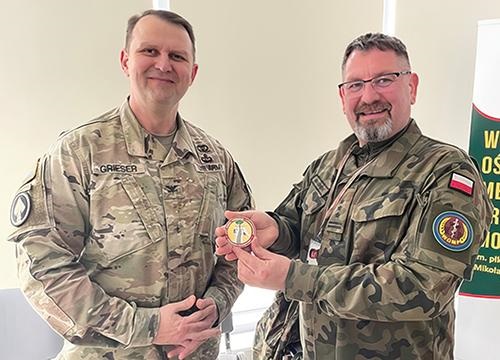As a deployable medical laboratory, the 1st AML is designed to run field-based clinical laboratory diagnostics and conduct health threat assessments
Clinical laboratory professionals may be surprised to learn that the US Army has a deployable medical laboratory that is equipped to perform the same menu of basic lab tests as their labs here in the United States, but in support of army units deployed in the field. At the same time, the Army’s deployable medical lab has the added responsibility of testing for infectious diseases and chemicals/agents that could be used by terrorists or enemy forces.
The 1st Area Medical Laboratory (AML) is based out of Aberdeen Proving Ground, Maryland, and operates within the Army’s 20th Chemical, Biological, Radiological, Nuclear and Explosives Command (CBRNE).
“The 1st Area Medical Laboratory identifies and evaluates health hazards through unique medical laboratory analyses and rapid health hazard assessments of nuclear, biological, chemical, endemic disease, occupational, and environmental health threats,” according to an Army new release.
A recent visit by the leaders of this lab unit to meet with their counterparts in Poland highlights the important diagnostic work the military prepares for by using this one-of-a-kind clinical laboratory model.

Col. Matthew Grieser (left), Commander of the 1st Area Medical Laboratory (AML) is shown above meeting with Col. Przemysław Makowski, MD, (right), Deputy Commander of the Military Preventive Medicine Center in Wrocław, Poland. Leaders from the US Army’s 1st AML visited military and medical officials in Poland. “It was a great opportunity to meet our Polish counterparts and to learn from one another,” said Grieser in an Army news release. “We intend to continue to strengthen this relationship … Poland is a great ally, and it was an honor to visit our counterpart organizations.” (Photo copyright: US Army.)
Role and Makeup of the 1st Area Medical Laboratory
The 1st AML traces its roots back to World War II, where it was one of 19 field laboratories spun up in 1944. It was deactivated after the Vietnam War and then reactivated in 2004. It is currently the Army’s only deployable field laboratory, according to the National Library of Medicine.
This specialized unit deploys worldwide to conduct threat detection and medical surveillance, according to the Army. For example, the military can send the 1st AML to locations where samples cannot quickly be transported to a fixed facility, or where there is a need for immediate hazard identification due to chemical or biological contamination or epidemic disease.
During the Ebola outbreak in Liberia in 2014-2015, the 1st AML operated four blood-testing laboratories and helped oversee two others manned by Navy personnel. The goal was to perform quick turnaround times to identify local residents who carried the disease, all while operating with extensive safety measures. More than 4,500 samples were tested during a six-month stay, Army Times reported.
As Dark Daily covered in “New High-Tech Mobile Medical Laboratories Deployed by the US Navy and a European Consortium Use Genetic Analysis to Get Rapid Diagnosis of Ebola,” one of the Navy labs located at Liberia’s capital, Monrovia, was able to reduce turnaround times for Ebola tests from days to hours.
The unit’s technical expertise features a combination of scientists, clinicians, and certified technicians. Familiar lab personnel include a microbiologist, a biochemist, and medical laboratory technicians.
1st AML Leaders Visit Polish Counterparts
Commanders from the 1st AML recently met with medical officials and chemical, biological, radiological, and nuclear experts from the Polish Armed Forces in the Warsaw area of Poland, the Army news release noted.
During the weeklong trip, 1st AML leaders toured the Epidemiological Response Center of the Polish Armed Forces, Military Institute of Chemistry and Radiometry, laboratories at the Polish Military Institute of Medicine, and biological and chemical labs at the Military Center for Preventive Medicine.
“It was a great opportunity to meet our Polish counterparts and to learn from one another,” said Col. Matthew Grieser, Commander of the 1st AML.
Maj. Suzanne Mate, the Chief of chemical threat assessment for the 1st AML, said meeting with allies helps to keep NATO ready for any contingency.
“It’s better to know your partners before you have to work together in a high-consequence situation,” said Mate in the Army news release. “We learned the strengths in different mobility platforms for laboratories and the capabilities within fixed scientific institutions to maintain standards and currency in chemical, biological, and radiological [CBR] investigations.
“This knowledge is invaluable when determining how to move a sample quickly and efficiently to characterize a suspected CBR threat when airlift resources are constrained or country treaties prevent movement activities,” she added.
Observant clinical laboratory managers will note similarities between their own jobs and those of the 1st AML. The military needs lab-based capabilities to perform a menu of diagnostic tests in support of Army units in the field and traditional clinical laboratories do the same in support of the healthcare providers they service.
—Scott Wallask
Related Information:
US Army Field Medical Laboratory Leaders Meet with Polish Counterparts in Warsaw
1st Area Medical Laboratory to Deploy for Ebola Mission



